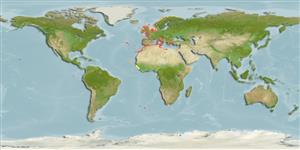Hexacorallia |
Actiniaria |
Aiptasiidae
Environment: milieu / climate zone / depth range / distribution range
Ecology
Sessile; depth range 0 - 50 m (Ref. 358). Subtropical
Atlantic and the Mediterranean: Azores Islands, Ireland to the Canary Islands.
Length at first maturity / Size / Weight / Age
Maturity: Lm ? range ? - ? cm
Diameter of the foot: 2.5 cm. Oral disc, tentacles not included/understood: 6 cm; cuts vertical, 20 cm. 136 tentacles: are laid out in 6 crowns around the siphonoglyphe; each one of them can measure up to 6 cm length. Coloring is fluctuating, rear related to the density of symbiotic algae, zooxanthella the, present ones within fabrics. The tentacles more or less transparent; and are avoided reasons in band or reticules, of white color to green, absent at ecotype I (Ref. 358).
Found on various rock funds, inside excavations and of cracks (Ref. 201). Known from infralittoral zones (Ref. 85338). Solitary (Ref. 2377).
Life cycle and mating behavior
Maturity | Reproduction | Spawning | Eggs | Fecundity | Larvae
Members of the class Anthozoa are either gonochoric or hermaphroditic. Mature gametes are shed into the coelenteron and spawned through the mouth. Life cycle: The zygote develops into a planktonic planula larva. Metamorphosis begins with early morphogenesis of tentacles, septa and pharynx before larval settlement on the aboral end.
Wirtz, P., O. Ocaña and T. Molodtsova 2003 Actiniaria and Ceriantharia of the Azores (Cnidaria Anthozoa). Helgoland Marine Research 57:114-117. (Ref. 201)
IUCN Red List Status
(Ref. 130435: Version 2025-1)
CITES status (Ref. 108899)
Not Evaluated
Not Evaluated
Threat to humans
Human uses
| FishSource |
Tools
More information
Trophic EcologyFood items (preys)
Diet composition
Food consumption
Predators
Population dynamicsGrowthMax. ages / sizesLength-weight rel.Length-length rel.Length-frequenciesMass conversionAbundance Life cycleReproductionMaturityFecunditySpawningEggsEgg developmentLarvae PhysiologyOxygen consumption
Human RelatedStamps, coins, misc.
Internet sources
Estimates based on models
Preferred temperature
(Ref.
115969): 10.2 - 20.5, mean 15.3 (based on 226 cells).
Price category
Unknown.
